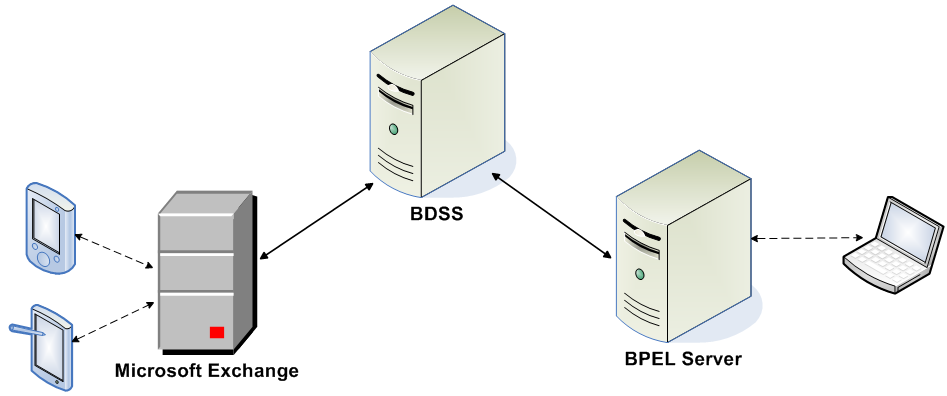1 Introduction to Oracle Business Data Synchronization Server
This chapter provides a general description of Oracle Business Data Synchronization Server (BDSS).
This chapter includes the following topics:
1.1 What Is Oracle Business Data Synchronization Server?
Oracle Business Data Synchronization Server (BDSS) is a synchronization service that enables server data stores to exchange and compare data. BDSS focuses primarily on interactions between Personal Information Management (PIM) data stores, such as Microsoft Exchange. For example, when a user changes a record for a particular domain of a connector (a connector domain), such as a ToDo item on one PIM server, BDSS automatically synchronizes that change to a corresponding ToDo item on another PIM server. Figure 1-1 illustrates an example of a BDSS installation, one that includes Microsoft Exchange interacting with other types of PIM data stores.
Note:
Although BDSS emphasizes the use of PIM data stores, you can extend BDSS for other types of data stores.1.2 Using BDSS
This section provides usage scenarios for synchronizing tasks and contacts.
Note:
BDSS is intended as a background process. As such, users are not required to perform any explicit action for synchronization. Users are aware of BDSS only when they notice that the records they create and modify in one system propagate to other systems.1.2.1 Creating a Task
An Exchange 2007 user creates a new task through the Microsoft Outlook client. After the user saves the task, Outlook synchronizes the task to the Exchange server hosting the user's mailbox. Later, when the user opens her account on another PIM server, the user notices that the task she created using the Outlook client appears in the ToDo list. When the user updates this task, BDSS updates the task in the Microsoft Exchange data store so that the user's Outlook client displays the updated task.
1.2.2 Storing Contact Information
When an Exchange 2007 user creates a new contact, BDSS synchronizes the contact record, writing it to the user's Outlook Contacts lists. When the user changes the spelling of a contact in Outlook, BDSS writes the change to the user's account on other PIM servers. After the record is written to this PIM server, all users that appear on the access list have the name change propagated to their Outlook Contacts list.
1.3 Configuring the Exchange 2007 Connector to Test Domain Synchronization
You can test the Hub's synchronization of the Task, Contact, and Calendar domains using the Exchange 2007 Connector, because it provides synchronization for multiple Hub domains. You can configure the Exchange 2007 Connector to present itself as any type of PIM server to the Hub, because server type is irrelevant to the Hub. If you configure a second Exchange 2007 Connector using the same PIM server type, the Hub can then synchronize between two different Exchange users as if it were synchronizing between two users of different PIM servers.
To test Hub synchronization:
-
Create a second connector. Differentiate this connector by giving a name such as Exchange2007_2.
-
Create a PIM server instance and a connector instance for this connector.
-
Configure the Pim Transport Implementation Class and Extract Response Batch Size parameters for each Exchange 2007 Connector whereby the value for the Profile is the name of the connector as it appears in the NAME column of the CONNECTORS table. For example, suppose you have deployed a single Exchange 2007 Connector and want to use the single instance to synchronize two Exchange 2007 users that are mapped to a single Hub user. Further, assume that Exchange2007 and Exchange2007_2 are in the NAME column of the CONNECTORS table and both have a SERVER_TYPE_CD corresponding to the Exchange2007 LOV value.
-
Add the following four rows to the PROFILES table using the
setProfileParameterof the ProfileRuntimeInfo MBean. For more information, see Section 4.8, "Managing Profiles."Table 1-1 Adding Profiles to Test Synchronization
Profile Section Parameter Value Exchange2007
Hub Transport
Pim Transport Implementation Class
oracle.bdss.connectors.exchange2007
pimtransport.PimTransportAdapter
Exchange2007
Hub Transport
Extract Response Batch Size
100000
Exchange2007_2
Hub Transport
Pim Transport Implementation Class
oracle.bdss.connectors.exchange2007.pimtransport.PimTransportAdapter
Exchange2007_2
Hub Transport
Extract Response Batch Size
100000
-
Create a connector user for each of the connectors.
Note:
You must use different Exchange users. That is, you cannot map john@exchange.com to john@exchange.com.
